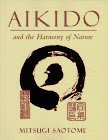In the previous post we saw how the whole word 'aikido' can be translated to English. Let's see now what the individual parts of the word mean. Fortunately, every sourse I came across mentioned that the aikido includes three parts, AI, KI and DO. The number of Japanese kanji for the word is also three. Let's see how the individual kanji are explained in the online sources I've seen. Obviously, there are several descriptions that are literally the same for many webpages (the old copy and paste method possibly), so I'll include one text only once. One of the best descriptions I think come from budodojo and from a web page in Hungarian (find it translated at the bottom of the list).
- Ai - harmony,
- Ki - spirit, mind or universal energy,
- Do - the Way
- Ai - harmony,
- Ki - spirit,
- Do - the Way or Path
- Ai - joining, harmonizing
- Ki - spirit, life energy
- Do - way, path
- Ai - to gather or harmonize
- Ki - universal life force/energy. This is the energy that we share with nature and all living beings
- Do - an artful path of discovery
- Ai - the kanji for AI (also pronounced GO and KATSU), as an ideogram, is often interpreted historically as a rice pot with a lid. This suggests the idea of meeting, joining or coming together. The character is often used to indicate harmony, union and reconciliation.
- Ki - The kanji for KI means spirit. It comes from the X character in the lower center, meaning rice. The radical to the top and leading down to the right represents vapor. Together they originally indicated the vapors rising from cooked rice and now indicate the idea of spirit or unseen force. Today it is generally used to indicate an invisible, spiritual energy or life force.
- Do - The DO kanji (also DO, TO, and michi) is composed of the wavy radical to the lower left meaning movement and the element to the right meaning head or chief. These were used to suggest the idea of the main road and finally came to mean way or road. In the context of aikido it takes on the common abstract meaning of way or way of enlightenment. DO is used in many Japanese words regarding traditional Japanese martial arts including; budo, judo, kendo, kyudo, karate-do, and dojo.
- Ai - translated as "harmony," this term is most commonly associated with aikido, where one combines their energy with that of their opponents.
- Aiki - "harmony meeting." When one combines an opponents' energy with their own for control.
- Ki - "spirit." Ideally, the mental and spiritual power summoned through concentration and breathing that can be applied to accomplish physical feats. This centralized energy, possessed by every person, can be manifested through the practice of just about any manifested through the practice of just about any martial discipline.
- Do - "way" or "path." When this term is used as a suffix to a particular style of the Japanese martial arts, it is indicitive of more than just a means of combat. Do indicates a disciplineand philosophy with moral and spiritual connotations, with the ultimate aim being enlightenment.
- Ai - 'to meet, to come together, to harmonize'.
- Ki - 'energy, spirit, mind'. In a larger context, Ki means 'the spirit of the universe', and not just the spirit of human beings.
- Do - 'the way'. It signifies that the study of Aikido does not involve merely self-defense techniques, but includes positive character-building ideals which a person can incorporate into his or her life.
- Ai - mutual
- Ki - spirit (from Middle Chinese khi)
- Do - art (from Middle Chinese daw', thaw).
- Ai - the first and most important kanji which means "meet, come together, harmonize".
- Ki - which means "soul, mind, spirit". In a larger context, Ki refers to the spirit of the universe and not just the spirit in human beings.
- Do - which means "the way", to signify that Aikido involves an outer and inner practice over the long term.
- Ai - unity, harmony, love, identifying with something
- Ki - living force, energy of centered power
- Do - way, means of something
- Ai - harmony
- Ki - energy, spirit
- Do - the way, path, road, philosophy of...
- Ai - it means 'harmony'. The aim of aikido is to create harmony. Harmony with ourselves, our partner we train with and harmony with the world.
- Ki - this requires a more explanation. The kanji itself has two parts. The part below the (approximately) horizontal line denote the rise fields, the part above show the vapour above the rise fields. It doesn't mean much for us westerners but the vapor above the rise fields means life and livelihood to the people of the East. The original meaning of this kanji has changed over the past centuries. Today Ki means universal living force, energy that is present everywhere. It is the same as chi in China and prana in India.
- Do - the meaning of Japanese do and Chinese tao are identical. Both of them mean 'way', 'road' or 'path', but not only the road we put our feet on but rather the road we walk on and we get somewhere; the way that leads to our objectives.
When I almost finished this post I was looking for individual kanji pictures and my Chinese colleague suddenly turned towards me and said 'I know this one!'. That was the 'do' kanji. So I took the opportunity to explore what these three kanji mean to the Chinese. Here's what she said, with approximate pronounciations:
- the AI kanji - [hei, he] - come together, fit
- the KI kanji - [chi, qi] - air, vital breath, 'if you don't have this you die'
- the Do kanji - [dao] - philosophy, path, way, direction, method, principle
Did I miss something important? Please let me know in the comments.













1 comment:
Yes, correctly.
Post a Comment